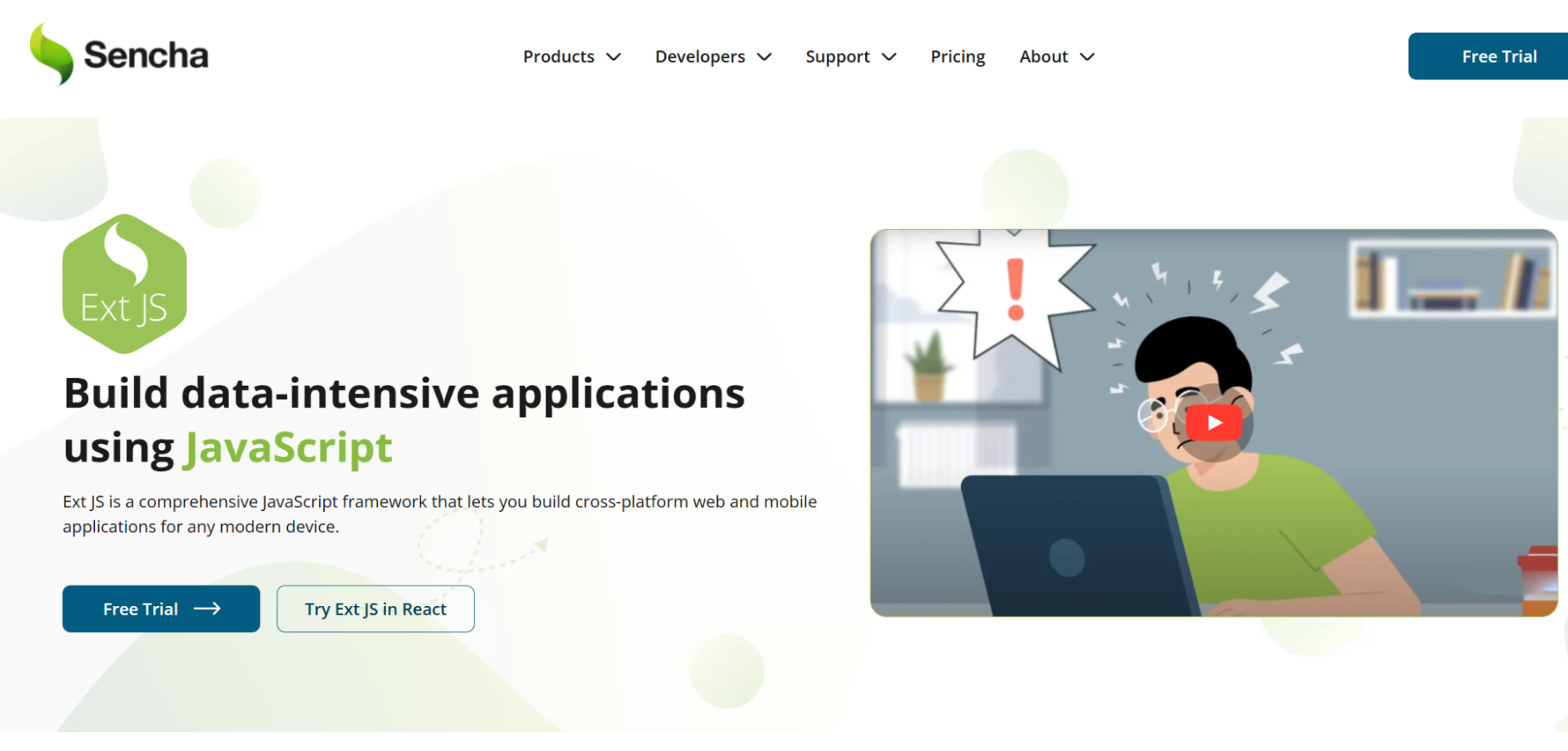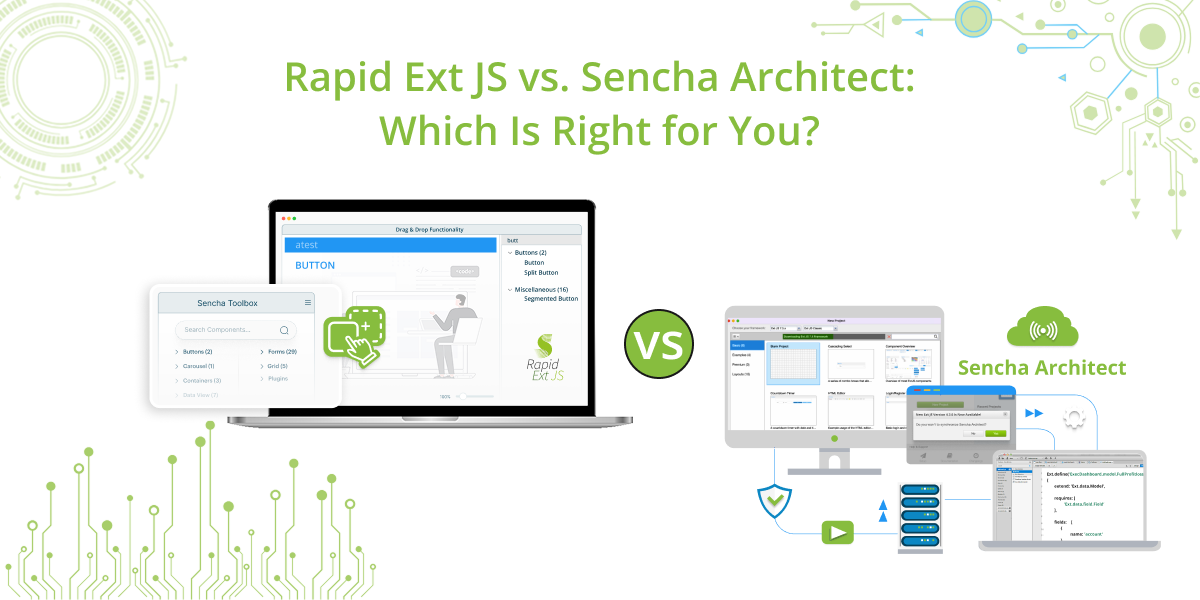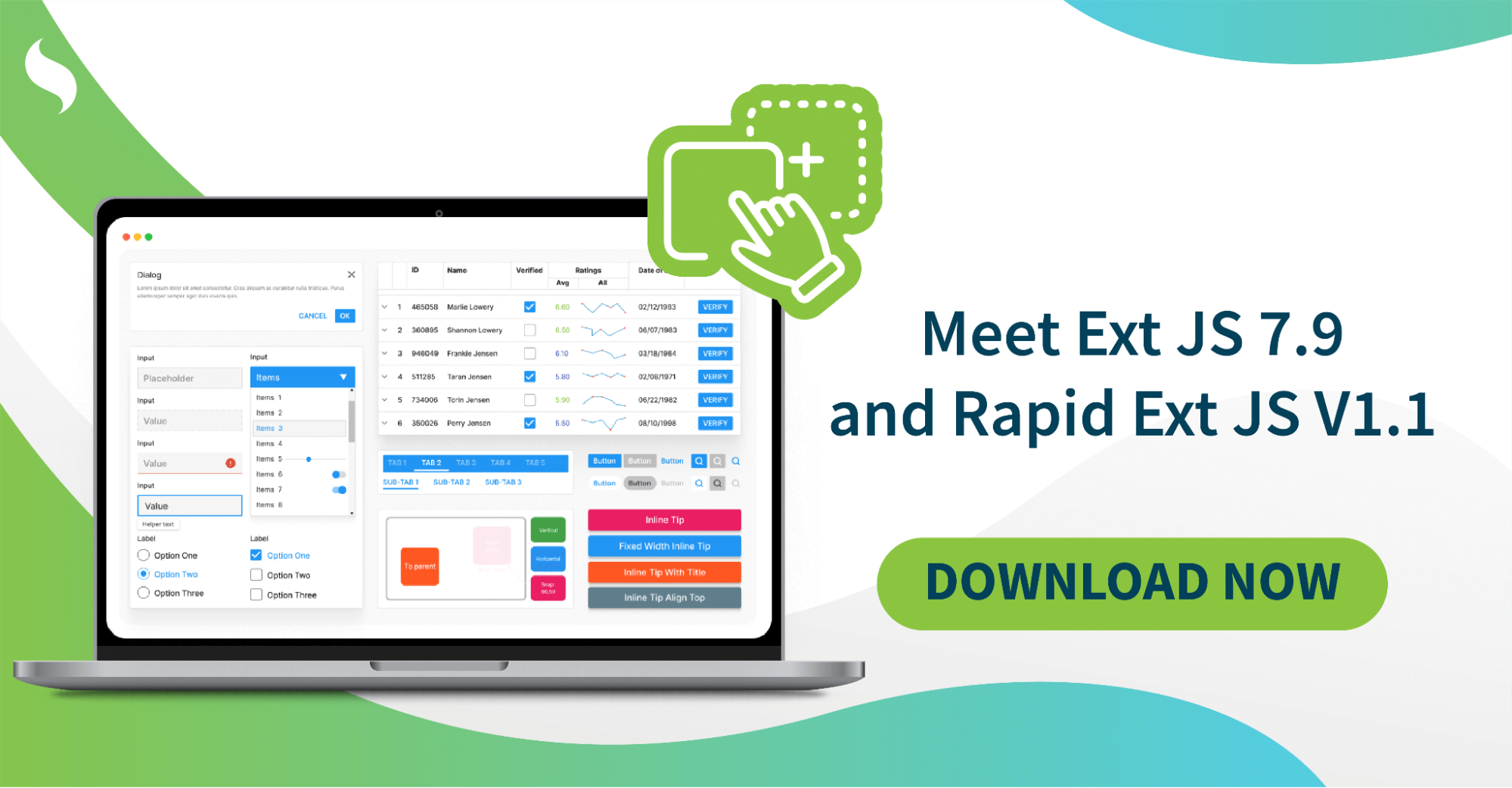Build Dynamic UIs with Recursive Components in JS Frameworks
To begin with, interactive UIs are a necessity in the present day. A dynamic UI is also crucial. It enhances the interface by improving the overall user experience. Dynamic UIs allow for real-time responsiveness without reloading a page. Unlike static interfaces, they adapt to user needs and live data. This results in quicker and better experiences.

Examples include e-commerce platforms, messaging apps, and data dashboards. These systems depend heavily on dynamic UIs. Since variables change frequently, updates are necessary. Dynamic UIs can be developed using JavaScript frameworks like Ext JS. Recursive components are a key feature for complex UIs.
Developers can create menus, tree views, and multi-level structures with these components. Recursive components store reusable code, eliminating the need to rewrite it. This makes the software development cycle easier, faster, and more organized. In this blog, we will explain how to use recursive components to create dynamic UIs.
We will cover dynamic data binding, event binding, and performance optimization. You will learn to develop deep and responsive applications. As a result, you will know how to create user-friendly web interfaces using JavaScript frameworks and recursive components.
What Are the Dynamic UIs?
Dynamic UIs are interfaces that change based on user actions or real-time data. They are more responsive than static UIs, creating a more engaging experience. Dynamic UIs allow content to change without reloading the page. This is achieved using technologies like JavaScript, React, and Angular.
The main goal of a dynamic UI is to enhance usability. For example, if a user inputs data, the UI can change based on location or preferences. Dynamic UIs boost interaction by updating content based on user selections. For instance, they can display stock prices that update in real-time.
Smooth animations, instant updates, and real-time changes improve user interaction. A simple example is an auto-complete search bar. As users type, suggestions update instantly based on input.
Dynamic UIs are often used in Single Page Applications (SPAs). SPAs rely on JavaScript frameworks to render content without reloading pages. This approach reduces clutter by focusing on relevant data. Applications with dynamic UIs are faster, cleaner, and more engaging.

Why Do You Need Dynamic UIs?
Dynamic UIs are essential for engaging and user-friendly applications. They make apps more interactive and reduce user frustration. Without dynamic UIs, users experience lags and delays. Dynamic UIs solve this by refreshing specific sections of a page. This creates a faster and seamless experience.
Dynamic UIs also improve user retention. When interfaces respond to user interactions, the system feels more personalized. For example, they show tailored recommendations or individualized content. This keeps users engaged and enhances their experience.
Additionally, dynamic UIs provide up-to-date information. Apps like messaging and stock platforms rely on real-time updates. These changes occur instantly, ensuring practical and safe user interactions.
Dynamic UIs reduce server burden by reloading only parts of a website. This minimizes unnecessary data transmission. The result is improved efficiency, especially in mobile apps and low-bandwidth areas.
What are Recursive Components?
Recursive components are among the most powerful features of Ext JS. When creating nested structures on our website, we rely on recursive components. We must note that we use these components to create nested structures within UI elements. But why do we implement recursive components? Their recursive nature enables us to create and maintain user interfaces. Let’s explore recursive components in more detail.
Use Cases in Ext JS
These components are used in scenarios where hierarchical structures are prevalent. There are many examples of it. Some examples are: Tree views Multi-level menus Dynamically generated forms. The recursive nature of components simplifies the development of user interfaces with varying levels of complexity.
Pros
Create scalable UIs Easier to organize and maintain Higher reusability
Cons
Requires careful design and documentation. It may impact performance for large-scale applications.

How Do You Build a Development Environment to Build Dynamic UIs With Recursive Components in Ext JS?

In this section, we will tell you about setting up the environment. This aims to build dynamic UIs with recursive components in Ext JS. Let’s begin.
Installing Ext JS
Before we begin implementing recursive components, it is essential to install Ext JS. One of the standout features of Ext JS is its comprehensive documentation. It provides detailed instructions for installation.
Step 1: Unzip the Ext JS Trial Zip File
Step 2: Install Sencha Cmd Sencha Ext JS gives instructions for MacOS, Linux, and Windows. Let’s proceed with Windows installation. Right-click to open the .exe file. Select “More Info” if a warning appears and click “Run anyway.”
Installation Steps:
Click ‘Next >’ Accept the agreement and click ‘Next >’
Choose the destination directory and click ‘Next >’
Complete the setup by clicking ‘Next >’
Click ‘Next >’ again Click ‘Finish’
You are now ready to create your first Ext JS Application.
Step 3: Get Started with Your First Ext JS Application
- 1. Open your terminal/command window.
- 2. Change the directory to where you want to create the app: `cd <folder-to-create-the-app>`
- 3. Generate the application: `sencha generate app modern -ext MyApp ./MyApp`
- 4. Navigate to the new application folder: `cd MyApp`
- 5. Run the application: `sencha app watch`
The Sencha command will build your application. Once complete, open any browser and view your application at http://localhost:1841/
Congratulations! You’ve successfully built an application using Ext JS! Next Steps Now that you’ve started building Ext JS applications let’s explore ways to use recursive components.
Configuring for Recursive Components
Take advantage of Ext JS’s comprehensive documentation before configuring for recursive components. It is a valuable resource made for developers. Plan the recursive component structure. In other words, you must consider its hierarchical nature and how instances will interact.
Use the Ext JS framework to define a recursive component class. Ensure that the class is designed to instantiate itself when needed. Implement mechanisms to handle dynamic data within the recursive component. This may involve recursive data loading and processing.
Use Sencha’s testing and debugging tools to ensure your recursive components function as intended. Pay attention to any potential issues related to recursion depth.

What is Dynamic Data Binding in JS Frameworks?
Dynamic data binding allows a connection between user interface elements and data. In other words, it enables real-time synchronization between your application’s data and presentation layer. Let’s consider an interesting example. If any changes in the data source occur, it will automatically update the changes on the application’s presentation layer. Dynamic data binding is one of the most important concepts in ensuring consistency and responsiveness.
Integrating Data
Integrating Data allows external data sources into an application. This integration provides meaningful content and functionality to users.
Dynamic Rendering
Dynamic rendering adapts and modifies the user interface based on changing data or user interactions. It ensures that the application’s display remains responsive and engaging.
Updating Components on Data Changes
Updating components on data Changes involves strategies for automatically refreshing UI elements when there are modifications to the underlying dataset. This dynamic updating ensures that the user interface accurately reflects the most recent data. As a result, we can maintain a fluid and user-friendly experience.

What is Event Handling in JS Frameworks’ Recursive Components?
Event Handling in Recursive Components manages user interactions or system-triggered events. It is important to note that this activity occurs within the hierarchical structure of recursive components. It addresses how these components respond to external stimuli. Besides, it plays an important role in enhancing interactivity. We need effective strategies for managing events in recursive components. It helps us handle and respond to various events.

What are the Advanced Techniques for Recursive Components in JS Frameworks?
Here are some of the most advanced techniques for recursive components. Interestingly, these techniques contribute to creating robust and high-performing applications. Let’s explore them.
Optimizing Performance
Optimizing Performance includes strategies to ensure efficient rendering and responsiveness. It is important, particularly in complex recursive structures.
Dynamic UI Updates
Dynamic UI Updates focus on advanced methods to adapt the user interface dynamically based on real-time changes. It helps us achieve a seamless and engaging user experience.
Handling Large Datasets
Handling Large Datasets explores techniques for managing extensive data within recursive components. It is important to note that you may also use Sencha’s data management tools. Sencha offers stores and models for handling data. As a result, we can address challenges associated with scalability and ensure optimal performance. Also Read: How to Create Professional Design with JavaScript Grid.

What are the Real-world Use Cases for JS Frameworks’ Recursive Components?
Real-world use cases for Recursive Components are diverse. Let’s explore them. In e-commerce, recursive components can facilitate dynamic product categorization.
In project management tools, these components aid in creating hierarchical task structures. As a result, they can enhance organization and clarity.
Educational platforms leverage recursive components for building nested course modules and interactive learning interfaces.
Content management systems benefit from recursive structures for flexible content categorization.
Any scenario requiring a scalable and adaptable hierarchical organization can find practical applications for recursive components.

What Are the Best Practices for Creating Dynamic UIs through Recursive Components?
Following these best practices will make your dynamic UIs more efficient, maintainable, and performant:
Keep Components Simple
Each recursive component should focus on one task. Avoid overloading it with too many responsibilities. Simplicity makes the code easier to read and reuse.
Limit Depth of Recursion
Don’t nest components too deeply. Excessive layers can cause performance issues. Keep the recursion depth reasonable.
Use Conditional Rendering
Render components only when needed. This helps optimize performance by avoiding unnecessary re-renders.
Pass Data Efficiently
Ensure data is passed correctly between components. Use props or state carefully to prevent unnecessary re-renders and deep prop drilling.
Optimize State Management
Manage state properly in recursive components. Use hooks like useState and useEffect to handle state and side effects efficiently.
Keep Recursion Tailored
Make recursive components specific to their use case. Avoid generalizing too much, as it can increase complexity and reduce performance.
Error Handling
Handle errors for edge cases, like infinite recursion or missing data. This ensures the stability of your application.
JS Frameworks: Conclusion
Building Dynamic UIs with Recursive Components in Ext JS helps us create responsive, adaptive, and user-centric web applications. Ext JS integrates recursive components that empower developers to create dynamic user interfaces. We have explored concepts, from dynamic data binding to event handling, to underscore the versatility of Ext JS. Advanced techniques like performance optimization and handling large datasets elevate the UI game. Ext JS stands as a powerful tool. As a result, it enables the construction of sophisticated, real-world applications with ease and precision.
JS Frameworks: FAQs
Can Recursive Components Handle Dynamic Data?
Recursive Components in Ext JS seamlessly handle dynamic data.
Why Choose Ext JS for Building Dynamic UIs Rather than Other JS Frameworks?
Choose Ext JS for dynamic UIs due to its robust framework.
What Is the Significance of Dynamic UIs in Web Applications?
It helps us update changed data in real-time and enhance user experience.
What Are the Best JS Frameworks?
Ext JS is one of the best frameworks for developers to implement recursive components.

When it comes to developing robust, enterprise-grade web applications, Sencha provides some of the most…

The Sencha team is excited to announce the latest Ext JS version 7.9 and Rapid…

It is important to select the best app development software with proper instructions that enhance…










